The NVIDIA SHIELD Tablet Review
by Joshua Ho on July 29, 2014 9:00 AM EST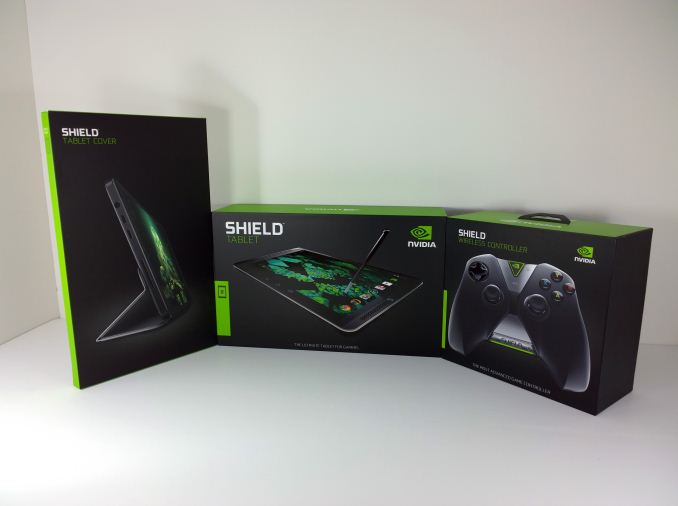
As I discussed in our launch article last week, the Shield tablet is very much the culmination of lessons learned from 2013. While the Tegra Note 7 was a decent tablet, it had to eke out a profit through hardware sales against competition that was willing to sell their tablets with no profit on hardware. Meanwhile the Shield portable was a good portable gaming device, but it was far too specialized to be anything but a gaming device. Without an established gaming ecosystem, NVIDIA struggled against established competitors.
As a result of these influences, today NVIDIA is becoming the first OEM to launch a serious gaming tablet running Android. While gaming tablets have been done before, they’ve been few and far between. Now it has always been technically possible to take a high end tablet and make it usable for gaming, but for the most part these attempts are marred by either the need for root or an application that requires extensive work on the part of the user to create proper control profiles for each game. In addition, the SoC in the tablet is often underequipped for intensive 3D gaming.
That’s where the Shield tablet comes in. With Tegra K1, a dedicated controller, 2x2 WiFi, and a huge amount of custom software, there’s definitely a lot of ground to cover. Once again, while the Shield tablet is a gaming device, it must also be a good tablet. To that end, NVIDIA has tried to differentiate this tablet with DirectStylus 2 and dual front facing speakers/bass reflex ports. I’ve included a table of specifications below to give a general idea of what the tablet is like.
| NVIDIA Shield Tablet | |
| SoC | Tegra K1 (2.2 GHz 4x Cortex A15r3, Kepler 1 SMX GPU) |
| RAM/NAND | 2 GB DDR3L-1866, 16/32GB NAND + microSD |
| Display | 8” 1920x1200 IPS LCD |
| Network | N/A or 2G / 3G / 4G LTE (NVIDIA Icera i500 UE Category 3/4 LTE) |
| Dimensions | 221 x 126 x 9.2mm, 390 grams |
| Camera | 5MP rear camera, 1.4 µm pixels, 1/4" CMOS size. 5MP FFC |
| Battery | 5197 mAh, 3.8V chemistry (19.75 Whr) |
| OS | Android 4.4.2 |
| Connectivity | 2x2 802.11a/b/g/n + BT 4.0, USB2.0, GPS/GLONASS, mini HDMI 1.4a |
| SIM Size | None or MicroSIM |
| Price | $299 or $399 (16GB/WiFi or 32GB/LTE) + $59 (optional controller) |
Hardware
Outside of the basic specs, the tablet itself has a much more subtle industrial and material design. While the large speaker grilles are maintained from the Tegra Note 7, the dimpled look and feel is gone. Instead, the finish is very much reminiscent of the Nexus 5. The feel isn’t quite rubbery the way soft touch finishes tend to be. Instead, it feels more like a high grain matte polycarbonate. Along the sides, there’s a noticeable chamfered edge where the back cover meets the display, although in practice this mostly affects aesthetics rather than in hand feel. The flip cover that is designed for the device is almost identical to the one in the Tegra Note 7, and folds up similarly. As with the Tegra Note 7, there are two angles that the flip cover can take. Overall, the aesthetic is much more subtle than the Tegra Note 7, and looks quite similar to the Nexus 7 (2013).
While it’s important for the tablet portion of the device to have decent material and industrial design, ergonomics and material design are critical for the controller. While the Shield portable had great ergonomics, it was heavy because the entire device had to fit in the controller. With Shield Tablet, that’s no longer the case. The result is that the controller is significantly lighter. While it still has some heft to it, I no longer feel the need to rest my hands against a table after significant playtime.
The controller itself is just as good as the one on the Shield Portable. The buttons, triggers, bumpers, and joysticks are all very close in feel. The one big difference are the tablet/Android controls. Instead of physical buttons, they’ve replaced the physical buttons with capacitive ones. The volume controls have also been moved down to the bottom of the controller and changed from a single button that triggers on-display volume controls to a rocker that allows direct manipulation of volume. Just above the volume rocker is a clickpad, which can be used to move a cursor through the UI. While this option exists, it’s a bit unpolished as the sensitivity isn’t tuned quite right to quickly navigate through the tablet.
Of course, there’s more to the controller than just the buttons and controls. NVIDIA has made sure to do things right by using WiFi Direct for communicating between the controller and the tablet. The frequency used depends upon what access point the tablet is connected to, so it can switch between 2.4 GHz and 5 GHz as necessary. NVIDIA claims that using WiFi Direct instead of Bluetooth drops latency by half, and also allows for microphone input and sound output via 3.5mm jack through the controller. In practice, the controller works great. I don’t have any complaints about this at all. Pairing is as simple as pressing and holding on the NVIDIA logo for a few seconds, then opening the pairing application. Up to four controllers can be paired to the tablet this way, which introduces interesting possibilities for local multiplayer games such as Trine 2. I also didn’t notice a difference in response time of the wireless controller when compared to the wired controller of Shield Portable. It’s incredibly important to get the controller right for gaming devices, and NVIDIA has nailed it. Overall, I’m happy with the basic hardware for both the controller and tablet. While it would be interesting to see a metal unibody design on the tablet, it’s difficult to justify at the price point that this device has to hit.
Of course, while hardware is important, software makes or breaks this tablet, so that’s next.


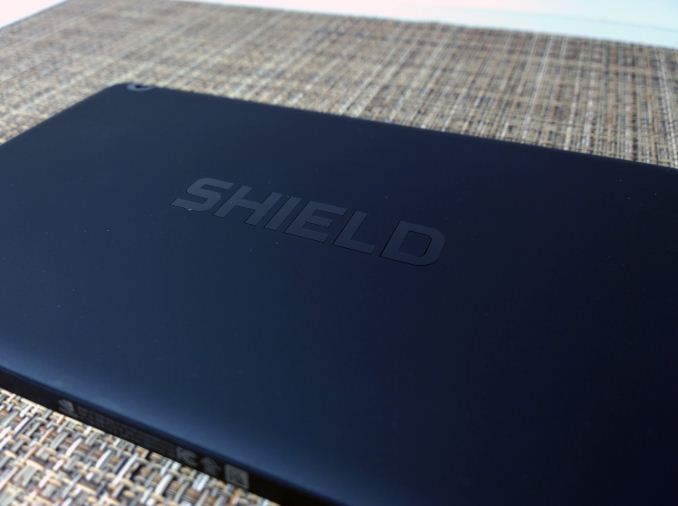
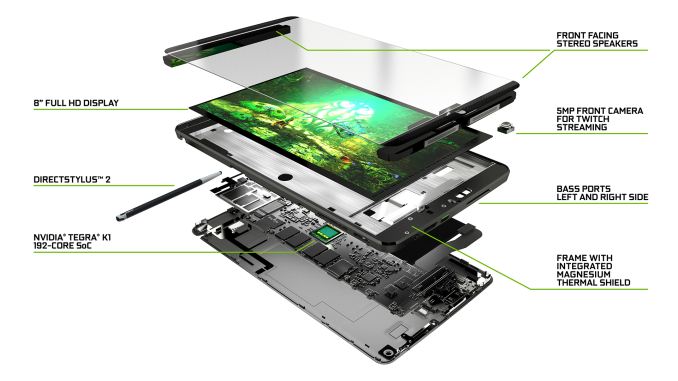
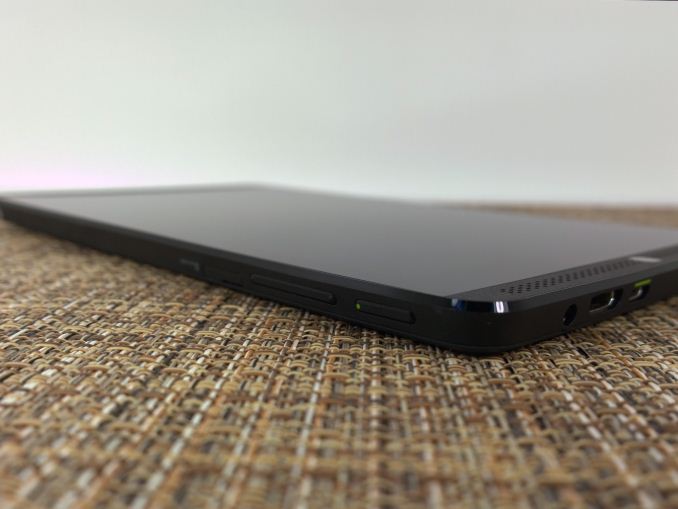
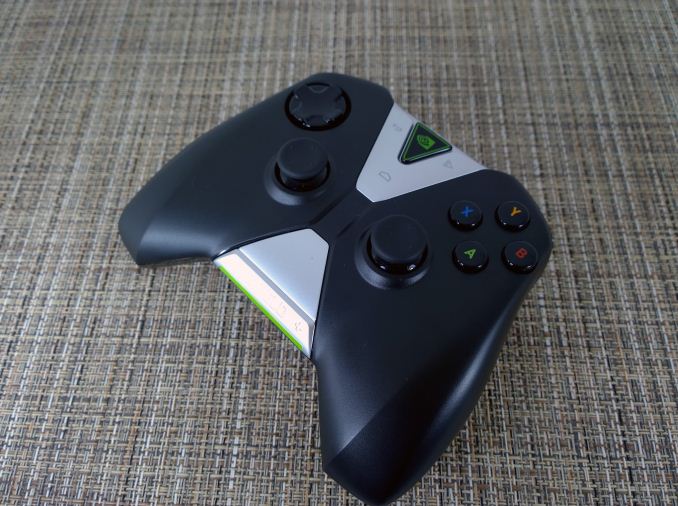








174 Comments
View All Comments
lmcd - Tuesday, July 29, 2014 - link
Well it's also the 2nd-most expensive tablet in the top 10, and most expensive in the top 5.Death666Angel - Tuesday, July 29, 2014 - link
How many people go to amazon to buy Apple products though? I would hazard a guess and say they more often than not get their gear through Apple stores directly?melgross - Tuesday, July 29, 2014 - link
Apple's tablet sales have been slightly on the down slide, wait for the new model, mode for a couple of months now. We'll what happens when the new ones come out in September.Jumangi - Tuesday, July 29, 2014 - link
The reality is the difference won't be "night and day" in the real world. The Nexus 7 is perfectly snappy using the 99.9% of apps that will actually be installed. Benchmarks are just that. So what if it gets 3 times the FPS on the T-Rex demo. There are real world practical reasons device makers have dumped Nvidia since the Tegra 3 for SoC vendors like Qualcomm. As powerful as the GPU is in this thing it will be a bit player in the worldwide SoC market.TheJian - Wednesday, July 30, 2014 - link
T4 is used in: Nvidia Shield, Tegra Note 7, Microsoft Surface 2, HP SlateBook x2, ZTE N988S, Nuvola NP-1, Project Mojo, Asus Transformer Pad Infinity (2013 model), Toshiba AT10-LE-A (Excite Pro), Vizio 10" tablet, Wexler.Terra 7, Wexler.Terra 10, Acer TA272HUL AIO, HP Slate 21 AIO, Xiaomi Phone 3, Wacom Cintiq Companion Hybrid, Coolpad, Mad Catz MOJO, BungBungame's Kalos tablet.More I can't be bothered to list, you should get the point. That's MS, HP, Toshiba, Acer, ASUS, Vizio, PNY/MSI/EVGA make the note7 IIRC, etc. How many vendors does a compnay need before you say a chip isn't failing?
K1 is coming in HTC Nexus 9, so google a bit player too? Nexus tablets sell very well. It was in everything google showed at Google IO this year (automotive, Tango, TV, Tablet). Seems to be a pretty decent bit player even before it really gets ramped. But whatever, I guess our definitions of bit player differ (greatly). You have to remember all revs before this were just buying time until desktop gpu met socs. Sort of like 7yrs it took to get cuda to dominate 90% of workstation graphics. With K1, many will know Nvidia's name is more than just PC gpus. Branding their own products was a brilliant move also, which will further this progress over time.
I hope they put out a 20nm console box (size of xbox1/ps4) with 125w psu and running 4ghz or something with HD or SSD etc, 16GB etc and put android gaming on the map for REAL. A 20nm Denver with Maxwell gpu should do fairly well and easily run 3.5-4ghz with a fan/heatsink on it in a big xbox1 like box (or TWO of them just like xbox1/ps4, Denver already runs 2.5ghz in a tablet). With 3.7B in the bank NV needs to start making $2-10mil games now in preparation for a CONSOLE launch that runs a triboot of linux, steamos (surely porting to ARM) and Android L with 64bit. Now that's a console I'd really like to see and streaming my PC also to that tv for PC games. To keep it cheap keep a slot empty for me to install a bluray on my own or have two options one with one without. No need for a 4K new bluray player then either. They need to start developing their own games and buy up some small software teams to get this done. With even just 200mil NV could pump out a good 50 $4mil games for android that really take advantage of their hardware and an announcement like that would cause some sales and gain major attention. Port them to PC later for more cash with amped up graphics. If you still fail to get your money back allow them to run on other devices as a last resort a year or two later after you've milked all the sales you can for your own devices. They only need to break even to push hardware sales, but I'm thinking they'd make some money on quite a few if they make quality games by small teams (like the grimrock guys, 4 guys made Legends of grimrock, snatch up teams like them).
NV is about to become a far larger player here just due to their desktop gpus migrating yearly to socs. You see the damage already in this review. The benchmarks will start to be well known as games start to be benchmarked for real and people wise up to who's running the best in GAMES. Qcom was great while modems dominated, we'll see how well they do in Nvidia's world now. NV will win the gpu war. Just ask Intel...LOL. Even AMD has a shot at making some cash if they'd get their butts in mobile gear (as in ARM, not x86 where Intel rules them). There is room in ARM land for both NV and AMD to rule many devices with gpus. Everyone already knows how to use their hardware inside out, Qcom has years to go here with ZERO experience in driver optimization for games etc. NV/AMD have been having a driver contest for 20yrs, and devs have been using their hardware for games for the same length of time. Good luck to everyone else here now that 50% of devs are making games for mobile devices (only PC tops that at 52%, consoles FAR behind these two).
titan10 - Thursday, July 31, 2014 - link
Just made an account to say that I loved your 'Just ask Intel...LOL',BTW great strategy... only if NV thinks same.savagemike - Tuesday, July 29, 2014 - link
We have an original N7 in the house and a 2013 N7. I want a little bigger screen and am really digging the idea of a stylus. Don't have a game console or a gaming desktop either. Not a huge gamer, obviously. But would probably use this for the occasional game. Just another bonus that it can do a decent job of that.Being a big percent heavier or thicker than something very light and very thin isn't a big deal in reality. What this Shield really seems to have is unending flexibility.
Knowname - Wednesday, July 30, 2014 - link
you can buy a stylus for 2 bucks lol though xD just sayin' this would obviously be a BETTER stylus and drawing apps, but if all you want is a stylus you might find your answer without emptying your wallet.SpartyOn - Tuesday, July 29, 2014 - link
A GTX 860m in a tablet? Surely this was a joke, right?The 860m pulls approximately 60w alone, maybe 50w if you paired it with DDR3 and downclocked it. In a tablet environment, you're looking at the entire SoC pulling 10w or less at load.
Not happening anytime soon.
That being said, if Nvidia could cram two Maxwell SMM units into the next Tegra vs. the one Kepler SMX in the K1, that would really be something.
schizoide - Tuesday, July 29, 2014 - link
I said crunch it down, obviously they wouldn't take the 60 watt card and plug it into a pci-e riser in a tablet. Compromises would be made, although less and less as time passes.My point was primarily that android gaming doesn't require high-end hardware, because the games target a low common denominator. An x86 windows based tablet makes a lot more sense for games.
Then again, most windows games require a mouse and keyboard.
Really, gaming tablets don't make sense as a separate market segment.